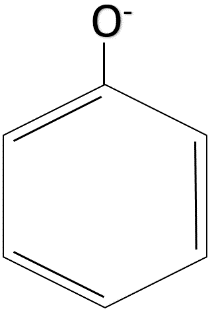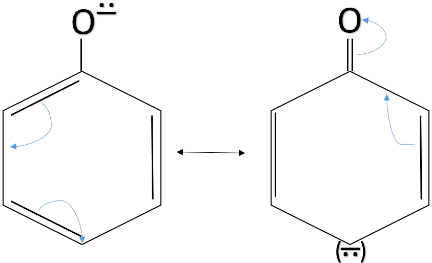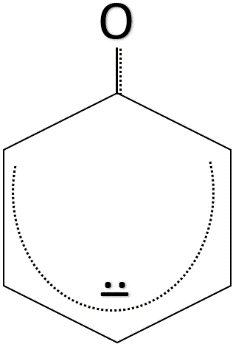
Answer
473.1k+ views
- Hint: The acidic character depends on the stability of the ion which is left behind after ${ H }^{ + }$ is released. Phenoxide ion is aromatic and can undergo resonance but ethoxide ion can’t.
Complete step-by-step solution -
Phenol is more acidic than that of ethanol because phenoxide ion is stabilized through delocalisation. Let us understand the reason why phenol is more acidic than ethanol.
The chemical formula of phenol is ${ C }_{ 6 }{ H }_{ 5 }-OH$. An acid loses ${ H }^{ + }$ ions in water. When phenol loses an ${ H }^{ + }$ ion, the ion formed is known as phenoxide ion. Its chemical formula is ${ C }_{ 6 }{ H }_{ 5 }-{ O}^{ -}$.
The negative charge formed as a result of losing an ${ H }^{ + }$ ion is not localised in phenol. The phenyl ring ${ C }_{ 6 }{ H }_{ 5 }-$ is an aromatic ring and it helps in delocalisation of the negative charge inside the ring.
This effect is called the resonance effect. It is the withdrawn or releasing effect of electrons from a particular substituent through the delocalisation of a charge.
The resonance effect takes place in compounds having a conjugated double bond system. In the conjugated double bond system, there are alternate single and double bonds. The phenoxide ion has an alternate system of single and double bonds. The structure of the phenoxide ion is given below.

The resonance structures which make the phenoxide ion stable are given below.





The chemical formula of ethanol is ${ CH }_{ 3 }-{ CH }_{ 2 }-OH$. As we can see that ethanol does not have any conjugated double bond system. So, when the ${ H }^{ + }$ ion leaves ethanol, the ethoxide ion formed is not stable as no resonance takes place and the negative charge is not delocalised. The formula of ethoxide ion is ${ CH }_{ 3 }-{ CH }_{ 2 }-{ O }^{ - }$.
Note: Always remember that in resonance effect the position of individual atoms does not move at all. Only the electrons in the pi cloud (Double bonded electrons) can be moved. Don’t confuse yourself while drawing resonance structures.
Complete step-by-step solution -
Phenol is more acidic than that of ethanol because phenoxide ion is stabilized through delocalisation. Let us understand the reason why phenol is more acidic than ethanol.
The chemical formula of phenol is ${ C }_{ 6 }{ H }_{ 5 }-OH$. An acid loses ${ H }^{ + }$ ions in water. When phenol loses an ${ H }^{ + }$ ion, the ion formed is known as phenoxide ion. Its chemical formula is ${ C }_{ 6 }{ H }_{ 5 }-{ O}^{ -}$.
The negative charge formed as a result of losing an ${ H }^{ + }$ ion is not localised in phenol. The phenyl ring ${ C }_{ 6 }{ H }_{ 5 }-$ is an aromatic ring and it helps in delocalisation of the negative charge inside the ring.
This effect is called the resonance effect. It is the withdrawn or releasing effect of electrons from a particular substituent through the delocalisation of a charge.
The resonance effect takes place in compounds having a conjugated double bond system. In the conjugated double bond system, there are alternate single and double bonds. The phenoxide ion has an alternate system of single and double bonds. The structure of the phenoxide ion is given below.

The resonance structures which make the phenoxide ion stable are given below.





The chemical formula of ethanol is ${ CH }_{ 3 }-{ CH }_{ 2 }-OH$. As we can see that ethanol does not have any conjugated double bond system. So, when the ${ H }^{ + }$ ion leaves ethanol, the ethoxide ion formed is not stable as no resonance takes place and the negative charge is not delocalised. The formula of ethoxide ion is ${ CH }_{ 3 }-{ CH }_{ 2 }-{ O }^{ - }$.
Note: Always remember that in resonance effect the position of individual atoms does not move at all. Only the electrons in the pi cloud (Double bonded electrons) can be moved. Don’t confuse yourself while drawing resonance structures.
Recently Updated Pages
Who among the following was the religious guru of class 7 social science CBSE

what is the correct chronological order of the following class 10 social science CBSE

Which of the following was not the actual cause for class 10 social science CBSE

Which of the following statements is not correct A class 10 social science CBSE

Which of the following leaders was not present in the class 10 social science CBSE

Garampani Sanctuary is located at A Diphu Assam B Gangtok class 10 social science CBSE

Trending doubts
A rainbow has circular shape because A The earth is class 11 physics CBSE

Which are the Top 10 Largest Countries of the World?

Fill the blanks with the suitable prepositions 1 The class 9 english CBSE

How do you graph the function fx 4x class 9 maths CBSE

The Equation xxx + 2 is Satisfied when x is Equal to Class 10 Maths

What is BLO What is the full form of BLO class 8 social science CBSE

Give 10 examples for herbs , shrubs , climbers , creepers

What organs are located on the left side of your body class 11 biology CBSE

Change the following sentences into negative and interrogative class 10 english CBSE




